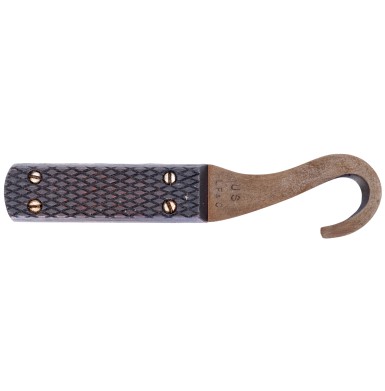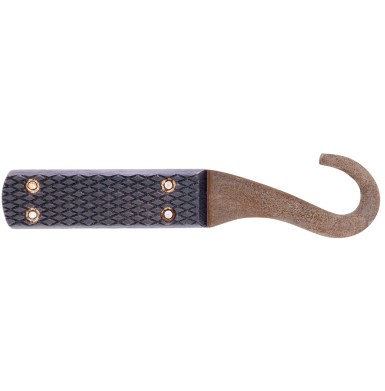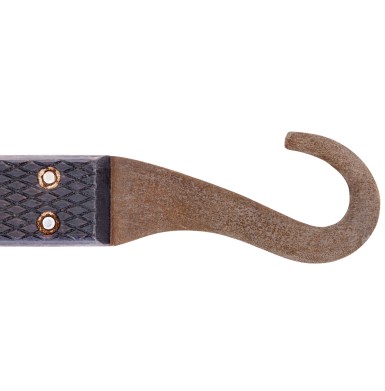Extremely Rare World War I LF&C Parachute Knife
- Product Code: EWSK-GB228
- Availability: In Stock
-
$2,495.00
While the various knives that saw use with American Paratroopers during World War II are relatively well known to collectors of military edged weapons, the fact that a Parachute Knife was produced in the United States during World War I is something that most collectors are generally unaware of.
From a historical standpoint, the use of parachutes during the Great War was extremely limited and with the exception of some clandestine nighttime insertions behind the lines done by the British, there was certainly no use of “airborne” troops during World War I. Additionally, with the exception of some late war use by the Germans and to a much lesser extent the Austrians, pilots were not issued parachutes. In fact, for a variety of reasons, the parachute was not a practical piece of equipment for combat aircraft of the period. Period parachutes were larger and bulkier than the ones we are more familiar with from the World War II period, meaning that they were not easily stowed or carried in aircraft of the Great War era. Additionally, the parachutes were static line deployment designs, not the type used by World War II flyers which were deployed by the airman after he escaped from the plane. Most planes of the period did not have the room in the cockpit to allow for a parachute to be worn by the pilot, and the additional weight and bulk could even have a negative effect on arial performance. The British Royal Flying Corps even prohibited the use of parachutes as a matter of policy, suggesting that if a pilot was given an opportunity to escape from a damage airplane, he was less likely to attempt to get the plane back to base where it could potentially be repaired and put back in service. It is worth noting that in 1918 German pilots began to be issued parachutes but documented uses of them as escape devices during the last year of the war is limited to less than 100.
Instead, parachutes were almost universally used by Observation Ballon Crews, who were regularly supplied with parachutes to escape a burning or falling balloon. Due to the fact that balloons were
inflated with extremely volatile hydrogen, they were extremely susceptible to ignition from a variety of sources, not the least of which were enemy machine gun bullets.
Apparently, the potential use of parachutes was considered by the US military with enough seriousness that a Parachute Knife was developed and produced by the American firm of Landers, Frary & Clark. L. F. & C. was established in 1865 and produced a wide variety of metal housewares, cutlery and even appliances. Many of their products were marketed under the trade name “Universal”. The products of L. F. & C. included everything from scales, mousetraps and ice skates to electric ranges and toasters. Most military collectors are aware of L. F. & C. because of the military edged weapons they produced, including the US Model 1913 Patton Saber, the triangular bladed US Model 1917 Trench Knife and the brass knuckle US Model 1918 Mk1 Trench Knife, among other items. The assets of the L.F. & C. company were purchased by General Electric in 1965.
Sometime circa 1917-1918 the firm manufactured at least a handful of the first US military parachute knives, that to my knowledge do not have an official military designation and are so rare that at least one reference suggests that only three are known to exist, but this could be somewhat apocryphal. The knife is shown on page 24 of Volume IV of M.H. Cole’s classic reference series US Military Knives, Bayonets & Machetes. Cole credits the example he shows to the collection of Larry Thomas and the pictured was drawn by Cole in 1983. The same information is reprinted on page 29 of The Best of U.S. Military Knives, Bayonets & Machetes by M.H. Cole and edited by Michael W. Silvey. The example offered here is attributed by the former owner as being the one used in the book by United States Military Knives: Collector’s Guide Michael Silvey & Gary Boyd on page 9. This was a limited production book, and I don’t have one in my extensive library could not find a reasonably priced used copy for sale. It is worth noting that the orientation of the slotted screw heads in the drawing in Cole’s book matches the orientation of the screw heads on this knife, making one wonder if this is the Larry Thomas knife that was used in Cole’s book, which was later used in the Silvey-Boyd book as well, possibly having been acquired by one of those two noted collectors at that time.
The L.F. & C. World War I Parachute Knife offered here is a published example as noted, and remains in wonderful, apparently unused condition. The knife measures nominally 6.5” in overall length, with a hooked safety cutting blade on the inner edge, similar to those used by First Responders to cut seat belts. Clearly the knife was designed to cut the parachute lines and straps to allow the parachutist to escape from entanglement after landing. It is worth noting that in the post-World War II period a parachute knife that combined the automatic blade of the Schrade-Presto parachute knife of World War II and the hooked blade of this design to offer both blades to a parachutist.
The knife has a full tang design with screw secured black stained wood scales that are 3.5” in length, 1” wide, slightly beveled and coarsely checkered at about 8 lines per inch. The scales are slightly more than a ¼” in thickness, measuring nominally .275” thick each. Four screws secure the grip scales with simple domed standard heads that enter countersunk nuts on the reverse. Both the screws and nuts are left bright. The full-tang blade is 6.5” in length with a 3” section exposed beyond the grip scales in the form of a hook with a single beveled safety edge on the interior of the hook. The blade and tang width are 1” at their widest point and taper to nominally .25” at the tip of the hook. The blade is .06” thick. The blade is finished in a dull grayish-brown color with the edge of the blade having a more bluish-black tone. While Cole calls the blade “blued” it has more the color of Parkerized metal, although the finish does not have the roughness often associated with Parkerizing. The blade’s ricasso is marked on the obverse in two lines:
US
L F & C
There are no other markings on the knife.
As noted, the knife remains in wonderful condition and is extremely crisp, showing no real signs of use. The blade retains the majority of the original dull grayish finish with scattered freckles of light surface oxidation and discoloration shot through the finish, most obviously on the reverse of the blade. The markings on the blade remain extremely crisp and sharp. The screws and nuts in the grip scales show some scattered light surface oxidation and some minimal slot wear but remain quite crisp. The wood grip scales are very crisp as well, with the checkering retaining extremely sharp lines and edges. The wood retains nearly all of the black stain, with some very minor thinning and fading. Overall, the knife remains in EXCELLENT condition.
This is one of the rarest US military knives I have ever had the pleasure to offer for sale. An exhaustive search of the internet could find no other examples of this knife discussed, pictured or having previously been offered for sale. This knife has been in an extremely advanced US military knife collection for at least two decades and may be the only example that has been sold in the last 20-30 years. For any advanced collector of US military knives, this is one of those “must have” items that you may not have another opportunity to acquire, and which could clearly be a centerpiece item in even the most advanced and extensive of collections.
Tags: Extremely, Rare, World, War, I, LF&C, Parachute, Knife






